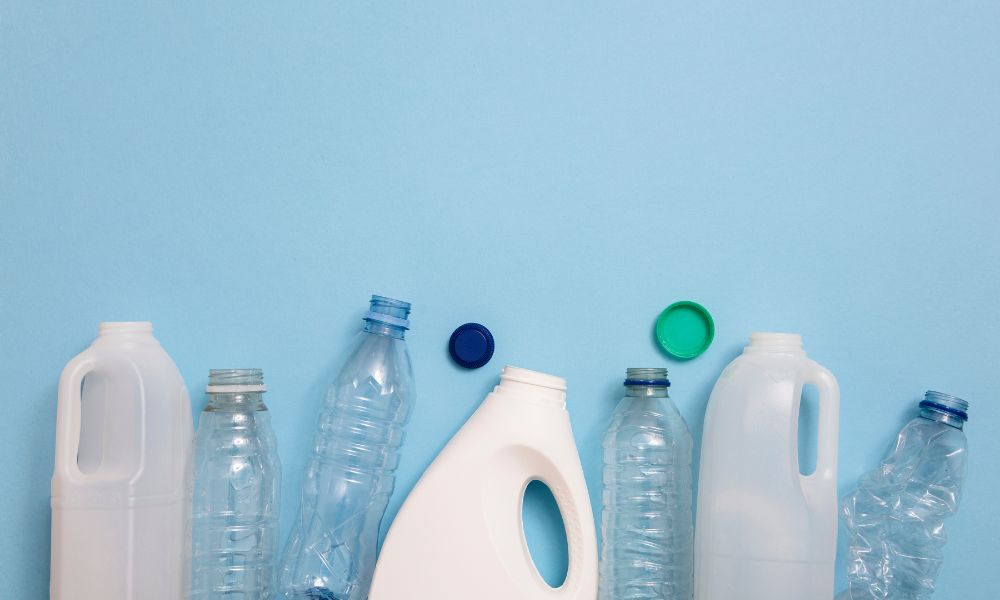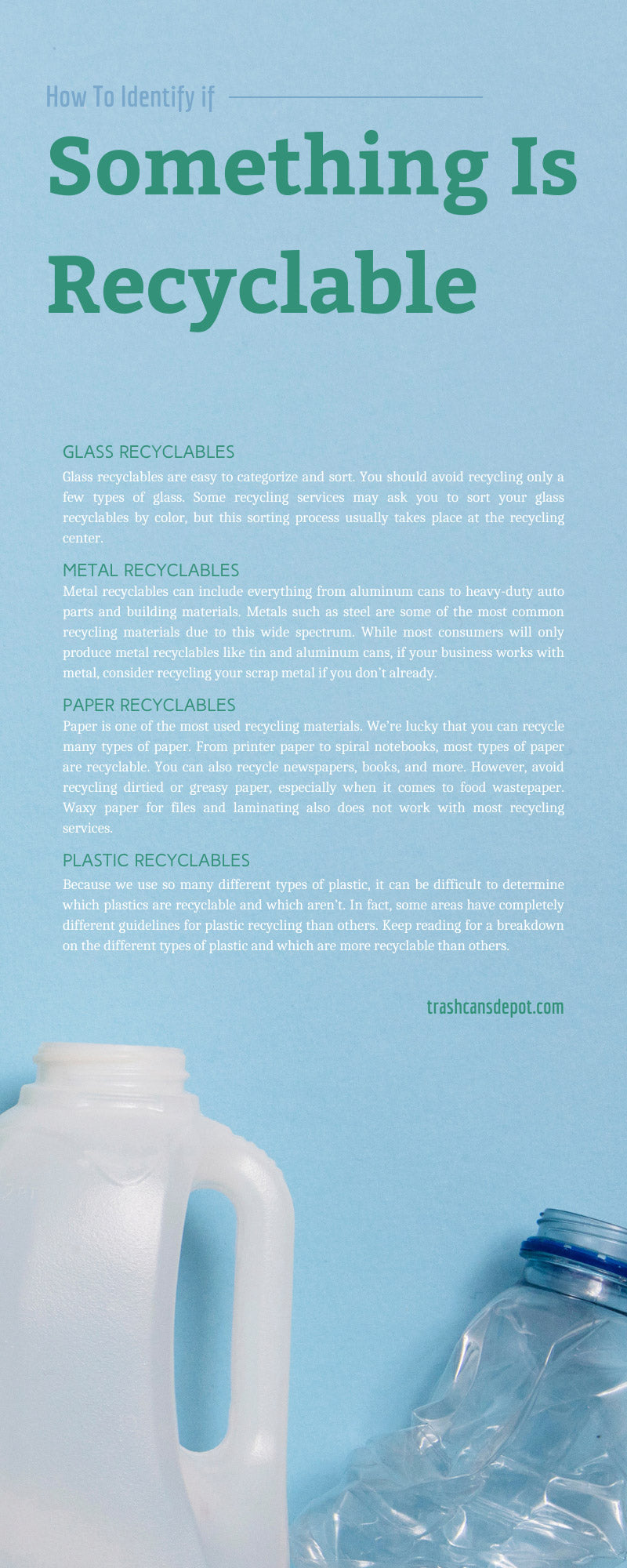
Practicing recycling in your home or business is a great habit for being more sustainable. However, don’t just toss any old plastic or glass product into the recycling bin. Unfortunately, not all products are recyclable, and you can cause recycling contamination by recycling the wrong materials. To better understand which products are recyclable and which aren’t, here is a quick guide to help you learn how to identify if something is recyclable.
General Recycling Guidelines
When it comes to identifying if a product is recyclable, you first need to familiarize yourself with the common recycling guidelines and main types of recyclables. Responsible recycling requires a lot of memorization of the individual recyclables and their categories, so it helps to start by exploring the most common types of recycling materials.
Glass Recyclables
Glass recyclables are easy to categorize and sort. You should avoid recycling only a few types of glass. Some recycling services may ask you to sort your glass recyclables by color, but this sorting process usually takes place at the recycling center. If you’re in need of extra outdoor recycling bins for your sorting needs, you can browse our selection here at Trash Cans Depot. Be sure to avoid recycling glass products such as windowpanes, ceramics, light bulbs, and other types of industrial or appliance glass. These products will usually require a specialty recycling service.
Metal Recyclables
Metal recyclables can include everything from aluminum cans to heavy-duty auto parts and building materials. Metals such as steel are some of the most common recycling materials due to this wide spectrum. While most consumers will only produce metal recyclables like tin and aluminum cans, if your business works with metal, consider recycling your scrap metal if you don’t already. Recycling scrap metal and metal parts can help reduce pollution and you may even get paid for your scrap metal in some areas.
Paper Recyclables
Paper is one of the most used recycling materials. We’re lucky that you can recycle many types of paper. From printer paper to spiral notebooks, most types of paper are recyclable. You can also recycle newspapers, books, and more. However, avoid recycling dirtied or greasy paper, especially when it comes to food wastepaper. Waxy paper for files and laminating also does not work with most recycling services. When recycling shredded paper, check with your local recycling service to see if they accept it, as shredded paper can pose problems for some recycling sorters.
Plastic Recyclables
Because we use so many different types of plastic, it can be difficult to determine which plastics are recyclable and which aren’t. In fact, some areas have completely different guidelines for plastic recycling than others. Keep reading for a breakdown on the different types of plastic and which are more recyclable than others.
How To Tell if Plastic Is Recyclable
Plastic recycling has its own classification and guidelines. This is because there are so many different varieties and different types of plastic. When plastic products are manufactured, they are labeled with a corresponding symbol and number to make the sorting process easier down the line. Recyclable plastic will feature the universal recycling symbol with a number stamped into the center of the symbol. This number helps identify the type of plastic and is crucial for determining which plastics are recyclable in your area.
Plastic number 1 & 2: Plastic number 1 and number 2 are the categories for polyethylene terephthalate and high-density polyethylene respectively. These two types of plastic are some of the most common recyclable materials. You can find these symbols on plastic products like water bottles, milk jugs, and other food and product containers. After a good cleaning, these plastic items are perfect recycling candidates.
Plastic number 3: Plastic number 3 is known as PVC or polyvinyl chloride. These plastics fall under the “maybe” category as far as recycling is concerned. Residential and commercial recycling services do not often accept PVC plastics for pickup. However, you may be able to find a specialty recycling service that accepts PVC plastic.
Plastic number 4 & 5: Plastic with the number 4 classification is known as LDPE plastic or low-density polyethylene. This type of plastic shows up in everything from food packaging to carpet materials and clothing. Due to their versatile makeup, category 4 plastics are not always accepted by collection services. Number 5 plastic, or polypropylene, is also used in food packaging and utensils. This type of plastic is becoming more widely accepted by recycling services.
Plastic number 6 & 7: Plastic number 6 is the category for polystyrene foam products, which commonly include Styrofoam cups, plates, take-out containers, packing materials, and more. Generally, most residential and commercial recycling services do not accept polystyrene plastic. Use polystyrene products as little as possible and dispose of them in the trash when you do. Plastic number 7 is a general category and contains a wide variety of plastic products, including water cooler jugs, baby bottles, and more. This category contains other plastics and resins that are not commonly recyclable.
Check Your Local Recycling Guidelines
Checking your local recycling guidelines is key to understanding which materials are and aren’t recyclable. Some recycling services accept unique types of plastics and other materials. If you live in a residential area or municipality with its own recycling collection, check your community’s website or newsletter for more information on recycling guidelines. If you run a business and utilize a local recycling collection service, check with your service provider directly to clarify which types of plastic and other recyclables they accept.
How To Remember Which Items Are Recyclable
Now that you know how to classify your recycling materials and how to find out if you can recycle them, committing all this to memory might feel like a daunting task. Help cement these guidelines into your memory by using recycling cheat sheets, charts, and infographics in your home or workplace. Utilizing these educational materials will also help your family or coworkers learn the same responsible recycling habits as well. You can use distinct recycling bins to separate materials, such as different colors of glass or different types of plastic.
When it comes to knowing how to identify if something is recyclable, all you need to do is follow your local guidelines and keep these general classifications in mind. If you have a question about a specific recycling material, reach out to your local recycling provider. And if you need resources for separating your recycling materials such as the assorted colors of glass or types of plastic, check out our selection of recycling receptacles here at Trash Cans Depot.


